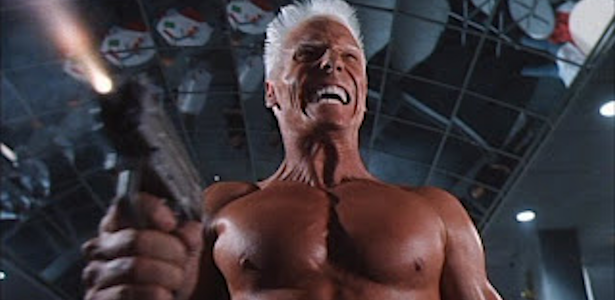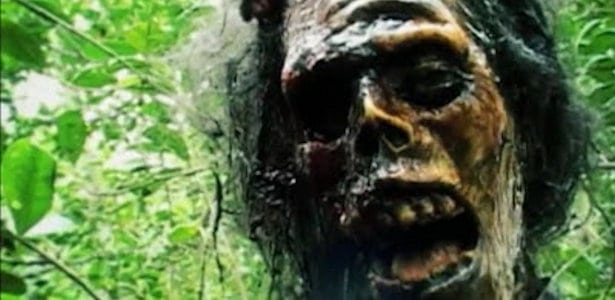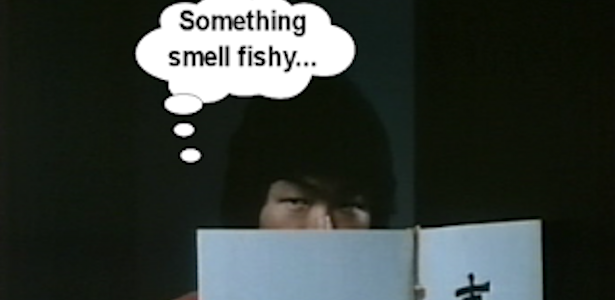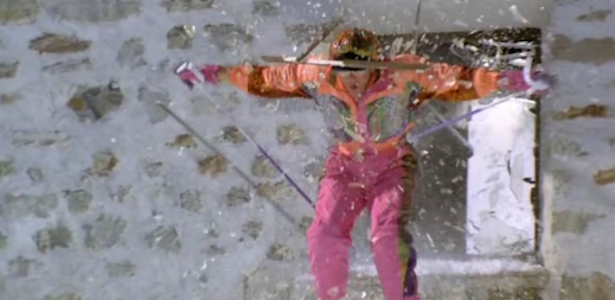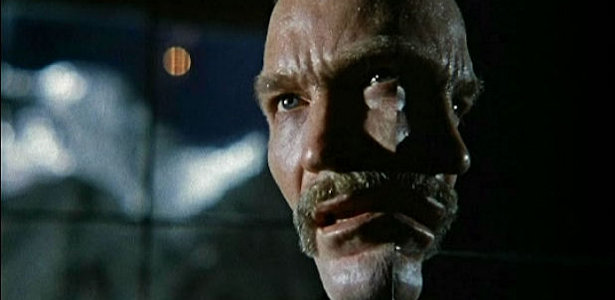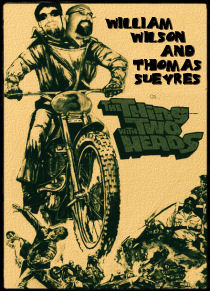As a series, I can’t think of a trilogy with a more bent trajectory. Walter Hill’s UNDISPUTED (2002) is another one of Hill’s staple “tough men in even tougher situations” and contains some of the same genes as his directorial debut, the bare-knuckle fighting Charles Bronson vehicle HARD TIMES (1975). Using the real life incarceration of boxing phenom Mike Tyson as a launching pad, Hill and frequent co-collaborator David Giler crafted a script about pro boxer George “Iceman” Chambers (Ving Rhames) being sent to prison for a rape and being challenged by resident prison boxing champ Monroe Hutchen (Wesley Snipes). The film performed so-so at the box office in August 2002, but proved to be very popular on home video.
That is pretty much it for the plot and this actually makes mixed martial arts tournament classics like ENTER THE DRAGON (1973) or BLOODSPORT (1988) look completely profound by comparison. But director Isaac Florentine realizes that the only thing better than a MMA tournament is a MMA tournament movie set in prison! This has all the required elements for a prison flick and a marital arts tournament flick. You get male bonding; the hole; crooked officials; sadistic “screws”; the sage old prisoner; steroids; improvisational work outs; a training montage; the “honor in fighting” routine; gambling; mutual respect; fickle inmate spectators; leg breaking; blood splattering; incredible comebacks against the odds; and tons of adrenaline-pumping fights. The only thing missing is a scene where a hot young woman spectator sitting with a rich old (preferably Asian) man is splashing by the blood of the participants…and loves it! Given the prison setting, it might be kind of hard but I’m sure Florentine spent nights anguishing on how to somehow work it in.
So if you are looking for some great martial arts action to kill 90 minutes, you can't go wrong with UNDISPUTED III. It is a throwback to the 80s and 90s Van Damme era where plots were simple and the fights were tough. No CGI enhanced bullshit or editing that is so haywire you can't even tell who is throwing a punch. It just might be the best prison movie featuring a Russian badass with a knee problem you see all year!
It was successful enough that producers Millenium and Nu Image films felt a direct-to-video sequel – the new rage in the home video market – would be worth the effort. Placed in the hands of DTV action staple Isaac Florentine, UNDISPUTED II: LAST MAN STANDING (2006) re-cast Chambers with Michael Jai White and, needing to justify their Bulgarian locations, has the Iceman framed while overseas and sentenced to do time in a hard-ass penitentiary. Naturally, the corrupt officials sense money to be made off their famous charge and pit him against resident Russian prison champ Boyka (Scott Adkins). The filmmakers have Chambers lose horribly so that – playing to White’s strengths – he must learn to incorporate martial arts into his repertoire in order to crush Boyka. All of this brings us to UNDISPUTED III: REDEMPTION (2010).
When the first sequel ended, Chambers was free from prison fighting and his soulless Russian opponent Boyka was nursing a crushed knee. Here, Boyka (Adkins again) returns as the lead in this film and is first shown disheveled, hobbled and living a solitary existence mopping floors. Secretly training to rehab his injured knee, Boyka demands a  shot against current prison champ Psycho (original!) and, after dispatching of him very quickly, is invited alongside his “handler” Gaga (Mark Ivanir) to an 8-man prison fighting tournament in the Republic of Georgia with the grand prize being freedom for the winner. These top fighters have been culled from various countries by mob factions. Of course, this is again one of these prison fighting tournaments that is ridiculously being advertised with posters and aired live in betting houses throughout Europe. Naturally, the crooked warden has his favorite in Colombian Quinones (Marko Zaror), who gets preferential treatment as he reads Spanish poet Federico Garcia Lorca while the other entrants do hard manual labor. And, as all good MMA movies recognize, Quinones is receiving illegal supplemental help. Why you cheatin' bastard! The deck is definitely stacked against the other seven combatants, so much so that their handlers bet against them. But Boyka, who has bonded with US prisoner Turbo (Mykel Jenkins), has other plans because, as he so eloquently puts it, “I am most complete fighter.”
shot against current prison champ Psycho (original!) and, after dispatching of him very quickly, is invited alongside his “handler” Gaga (Mark Ivanir) to an 8-man prison fighting tournament in the Republic of Georgia with the grand prize being freedom for the winner. These top fighters have been culled from various countries by mob factions. Of course, this is again one of these prison fighting tournaments that is ridiculously being advertised with posters and aired live in betting houses throughout Europe. Naturally, the crooked warden has his favorite in Colombian Quinones (Marko Zaror), who gets preferential treatment as he reads Spanish poet Federico Garcia Lorca while the other entrants do hard manual labor. And, as all good MMA movies recognize, Quinones is receiving illegal supplemental help. Why you cheatin' bastard! The deck is definitely stacked against the other seven combatants, so much so that their handlers bet against them. But Boyka, who has bonded with US prisoner Turbo (Mykel Jenkins), has other plans because, as he so eloquently puts it, “I am most complete fighter.”
 shot against current prison champ Psycho (original!) and, after dispatching of him very quickly, is invited alongside his “handler” Gaga (Mark Ivanir) to an 8-man prison fighting tournament in the Republic of Georgia with the grand prize being freedom for the winner. These top fighters have been culled from various countries by mob factions. Of course, this is again one of these prison fighting tournaments that is ridiculously being advertised with posters and aired live in betting houses throughout Europe. Naturally, the crooked warden has his favorite in Colombian Quinones (Marko Zaror), who gets preferential treatment as he reads Spanish poet Federico Garcia Lorca while the other entrants do hard manual labor. And, as all good MMA movies recognize, Quinones is receiving illegal supplemental help. Why you cheatin' bastard! The deck is definitely stacked against the other seven combatants, so much so that their handlers bet against them. But Boyka, who has bonded with US prisoner Turbo (Mykel Jenkins), has other plans because, as he so eloquently puts it, “I am most complete fighter.”
shot against current prison champ Psycho (original!) and, after dispatching of him very quickly, is invited alongside his “handler” Gaga (Mark Ivanir) to an 8-man prison fighting tournament in the Republic of Georgia with the grand prize being freedom for the winner. These top fighters have been culled from various countries by mob factions. Of course, this is again one of these prison fighting tournaments that is ridiculously being advertised with posters and aired live in betting houses throughout Europe. Naturally, the crooked warden has his favorite in Colombian Quinones (Marko Zaror), who gets preferential treatment as he reads Spanish poet Federico Garcia Lorca while the other entrants do hard manual labor. And, as all good MMA movies recognize, Quinones is receiving illegal supplemental help. Why you cheatin' bastard! The deck is definitely stacked against the other seven combatants, so much so that their handlers bet against them. But Boyka, who has bonded with US prisoner Turbo (Mykel Jenkins), has other plans because, as he so eloquently puts it, “I am most complete fighter.”
“He's totally behind me, isn't he?”
Florentine took a step back technically as a director with NINJA (2009) where he foolishly tried to emulate big Hollywood films with flashy camera moves and, worst of all, computer-generated blood. Thankfully, he returns to form here and remembers what makes his films so enjoyable (well choreographed fights). Florentine is still in love with his crash zooms but wisely keeps them out of the fights for the most part. And the  fights are the real reason to see this. Florentine assembles a group of diverse talents from all over the globe including Lateef Crowder (who is known for the amazing Capoeira fight with Tony Jaa in THE PROTECTOR [aka TOM YUM GOONG]) and Marko Zaror (emerging martial arts star from Brazil with the features KILTRO and MANDRILL). A real stand out acting wise is Mykel Jenkins as the American in the tournament who bonds with Boyka. And, of course, you have to talk about lead Scott Adkins. Adkins might be one of the best marital artists in films today and gets to stretch his acting chops again, something NINJA denied him. As the title implies, the UNDISPUTED II villain does a 180 here and it is handled better than you would expect. He doesn’t become a softie by any means as he maintains his over-the-top gruffness, but they do allow the character enough moments to successfully transfer to commendable protagonist.
fights are the real reason to see this. Florentine assembles a group of diverse talents from all over the globe including Lateef Crowder (who is known for the amazing Capoeira fight with Tony Jaa in THE PROTECTOR [aka TOM YUM GOONG]) and Marko Zaror (emerging martial arts star from Brazil with the features KILTRO and MANDRILL). A real stand out acting wise is Mykel Jenkins as the American in the tournament who bonds with Boyka. And, of course, you have to talk about lead Scott Adkins. Adkins might be one of the best marital artists in films today and gets to stretch his acting chops again, something NINJA denied him. As the title implies, the UNDISPUTED II villain does a 180 here and it is handled better than you would expect. He doesn’t become a softie by any means as he maintains his over-the-top gruffness, but they do allow the character enough moments to successfully transfer to commendable protagonist.
 fights are the real reason to see this. Florentine assembles a group of diverse talents from all over the globe including Lateef Crowder (who is known for the amazing Capoeira fight with Tony Jaa in THE PROTECTOR [aka TOM YUM GOONG]) and Marko Zaror (emerging martial arts star from Brazil with the features KILTRO and MANDRILL). A real stand out acting wise is Mykel Jenkins as the American in the tournament who bonds with Boyka. And, of course, you have to talk about lead Scott Adkins. Adkins might be one of the best marital artists in films today and gets to stretch his acting chops again, something NINJA denied him. As the title implies, the UNDISPUTED II villain does a 180 here and it is handled better than you would expect. He doesn’t become a softie by any means as he maintains his over-the-top gruffness, but they do allow the character enough moments to successfully transfer to commendable protagonist.
fights are the real reason to see this. Florentine assembles a group of diverse talents from all over the globe including Lateef Crowder (who is known for the amazing Capoeira fight with Tony Jaa in THE PROTECTOR [aka TOM YUM GOONG]) and Marko Zaror (emerging martial arts star from Brazil with the features KILTRO and MANDRILL). A real stand out acting wise is Mykel Jenkins as the American in the tournament who bonds with Boyka. And, of course, you have to talk about lead Scott Adkins. Adkins might be one of the best marital artists in films today and gets to stretch his acting chops again, something NINJA denied him. As the title implies, the UNDISPUTED II villain does a 180 here and it is handled better than you would expect. He doesn’t become a softie by any means as he maintains his over-the-top gruffness, but they do allow the character enough moments to successfully transfer to commendable protagonist. 



